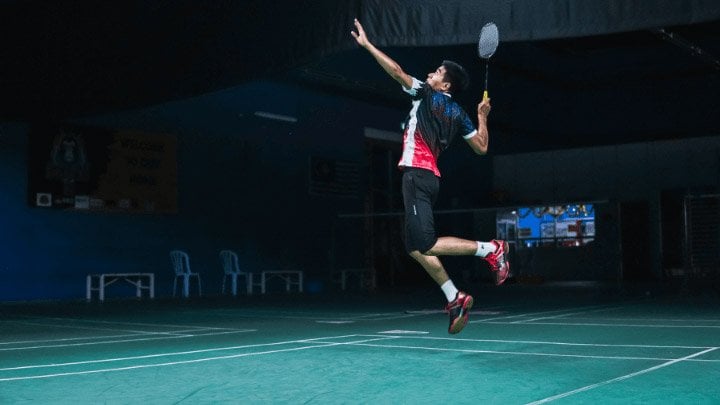There are many reasons why you might want to build an indoor badminton court.
The nearest badminton court to your home might not be so near after all. Its monthly subscription fee might be pinching your pocket. You might not feel like having the energy to travel to the court every day after coming home from work in the evening.
Whatever your reason, this article will provide you with a step-by-step guide to building an indoor badminton court, So that you can play the game whenever you’re in the mood.
Step 1. Zero in on the Location
Most people who plan to build an indoor court ignore the fact that they need a walkable area on all four sides of the court.
The universal rule dictates that a badminton court has dimensions of 44ft by 20ft, but side galleries aren’t included in this dimension.
In order to have a walkable side gallery, the dimensions of the hall in which you’d set up the court should ideally be 55.8ft by 26.4ft.
Only after you’re a hundred percent confident that your hall’s size is equal to or bigger than the abovementioned dimensions should you move to the next step.
Step 2. Choose the Flooring
After making sure that you have the space needed to build an indoor badminton court, it would be time to choose the flooring.
If the flooring isn’t right, if it is uneven or has a jagged surface with rocks, pebbles, and stones, the whole purpose of this project would fail.
The flooring should be comfortable to work on and mustn’t expose the badminton players to falls or injuries.
It should have a good amount of shock absorption (at least 30%) and must also be anti-slip to prevent slippage.
Here are various types of flooring used in indoor badminton courts:
1. Wooden
According to the Badminton World Federation’s (BWF’s) official rule book, it is preferable to have a springy wood floor with anti- or non-slip mats.
Wooden flooring allows smooth and unrestricted movement to badminton players across the court, while also ensuring maximum shock absorption to minimize the risk of common jump injuries.
Which wooden flooring is best for an indoor badminton court?
Hardwood flooring is the most commonly used for indoor badminton courts. Most of the time, it is given a laminate coating to enhance its appearance and durability.
2. Synthetic
Synthetic badminton court flooring is available in two major types, including PVC and acrylic.
a. PVC
Available in the form of mats, PVC synthetic courts are popular because of their eye-catching appearance, long-lasting durability, and excellent anti-slip properties.
However, in most cases, PVC floors aren’t installed alone but on top of wooden flooring to enhance the latter’s sought-after properties.
b. Acrylic
Acrylic badminton court flooring attracts people who are on a budget.
Available in several colors, their anti-slip properties can match that of PVC, though they are not as durable and long-lasting.
3. Rubber Mat Flooring
Rubber mat floorings are the latest trend in indoor badminton courts as they protect the floor while also minimizing fatigue and injuries.
These floorings are non-toxic, easy to install and maintain, and they offer good shock absorption to minimize the likelihood of jump injuries.
On the flip side, rubber mat floorings have a higher upfront cost, and they require dry-fitting during installation.
Step 3. Draw Boundaries/Lines
Use some duct tape, paint or chalk to mark the boundaries. You can draw the boundaries in the following order:
- Draw the outermost lines first. They are 44ft by 20ft
- Make “Sidelines” inside the outer lines, which are lines drawn along the length of the court. If the shuttlecock lands outside these lines when playing singles, the other player gets one point.
- Draw “Front Service Lines,” which are horizontal lines right next to the net, on both sides of the net. Badminton rules dictate that for a service to be valid, it shouldn’t land within the front service lines.
- Make “Back Service Lines.” They are also horizontal to the net but are drawn next to the outermost lines.
- Draw a line to divide the court in half. This line should begin from the outermost line and end at the front service line. Needless to say that it should be drawn on both sides of the court.
Step 4. Set up the Badminton Net
Standard badminton nets start at 2’6” above the ground (from the bottom). They are 5’1” at the edges and should sag slightly at the center, dropping to a height of 5′.
After purchasing a net meeting these criteria, make sure to gather the following items:
- Hammer
- Rope
- Badminton net kit
- Tape
- Stalks
- Spray paint
Once you have all these items handy, follow these instructions:
1. Assemble Poles
Depending on the poles your net came with, the pole setup will be different. Let’s take a look at various types of pole setups.
a) Bottom Poles
Some nets come with bottom/telescopic poles to let you adjust the net stand on both sides. You can easily adjust such nets by pushing one pole into another.
To assemble a net that came with bottom poles, start from one side by pushing one of the poles into another, before fitting it with the T-shaped foot.
Follow the same instructions to assemble the net stand on the other side.
b) Two Stands
Some nets don’t come with poles. Instead, they have two stands for fixing with the ground.
If you have purchased one of these nets, push one pole into another and insert a stake into the ground.
Next, pull the net taut and note down the distance from one pole to the other before determining where you’ll set up the second pole. Based on your calculations, insert the second pole into the ground.
c) Pop-up
Pop-up badminton nets are popping up everywhere these days (see what I did there!).
They come with a center-weighted-based foot that supports the entire structure. These nets are a cinch to install.
If you have bought one of these nets, start by assembling the feet first, before attaching both feet to the center poles.
Like badminton nets described above, a pop-up net also comes with separable poles. Fit both poles with each other by pushing one into another.
2. Tie Up The Net
Your net must have come with loops or eye bolts. If it didn’t, it’s time to purchase a couple of pairs of these.
Start by tying the upper part of the net to the top of the pole, before tying the lower part to the bottom of the pole. After you have tied up the net at one side, it’s time to move to the other side.
Tip: Some net stands come with pockets on both sides. They don’t need loops or eyebolts. All you have to do is to insert the top of the pole into the pocket, before tying the opposite part of the net with the pole.
Step 5. Set up Floodlights
One of the reasons most people want to build an indoor badminton court is to have the freedom to play the game at any time of the day.
That is why selecting the right lighting for your badminton court is crucial, as selecting wrong and/or inadequate lighting can ruin the entire experience.
It is recommended to use LED high bay light and LED linear high bay light in badminton courts, as they are much better than other types of lighting in evenness, comfort, and anti-glare.
What is the illumination level for the badminton court?
Unless you’re planning on organizing high-scale events in your indoor badminton court, 1000lux lighting will be more than enough, provided they are hung evenly across the court.
Frequently Asked Questions
What are the dimensions of a badminton court?
According to the BWF, a standard badminton court has dimensions of 44ft by 20ft.
How much area is required for a badminton court?
If you include the length of the galleries, an indoor badminton court must ideally be 55.8ft by 26.4ft.
How much cost to build a badminton court?
The cost to build a badminton court depends on multiple factors, including the evenness of the ground where you’re planning to set up the court, the cost of court mats, nets and complimentary items (guy wires and poles), and materials you’re using to create the boundaries.
How to draw badminton court lines?
Use some duct tape, chalk, or paint to draw badminton court lines.
How high is the net on a badminton court?
A badminton court net must have a height of 5’1” at the edges and should sag slightly at the center, dropping to a height of 5′.
Conclusion
It isn’t easy to build an indoor badminton court. However, the freedom that an indoor badminton court offers, by letting you play the game any time you feel like it, will make all the time and effort you put into building one worth it.
Now I want to hear from you:
- What do you think is the most difficult step in building an indoor badminton court?
- Do you prefer wooden or rubber flooring?
- What sort of lights have you decided to go with?
Feel free to reach out to me in the comments section below, I’d love to answer your questions and hear your feedback. We are also on Instagram @healthyprinciples_.








